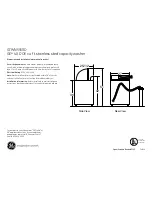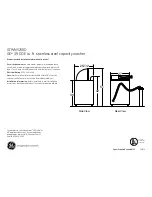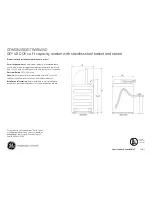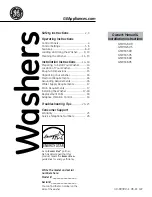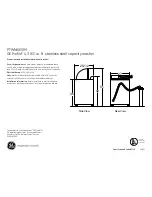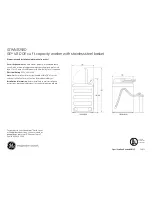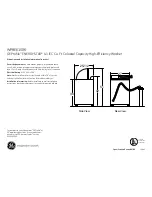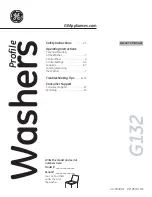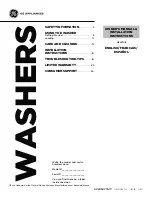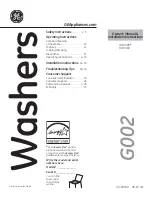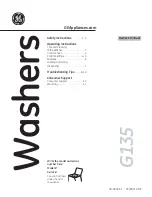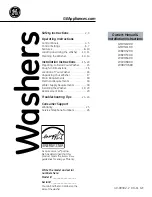
Cut Hazard
Electric Shock Hazard
Disconnect electrical power at the fuse box
or circuit breaker box before beginning
installation.
Failure to follow this warning could result in
death or serious injury
.
Metal color panels are sharp and should be
handled with care. Wear gloves to protect
hands.
Failure to follow this warning may result in
injury.
Checking the Installation
9
Operate the machine through at
least one fill and pump-out,
checking the following items:
On EIDW5905 press and hold down HI-TEMP Icon for
5 - 10 seconds before first use.
At first fill, approximately 2 minutes, make sure water
completely covers filter surface.
At pump-out: (pump-out is either when the cycle is
completed or canceled. refer to the Use and Care Manual
for Start/Cancel), make sure all water is pumped out.
Check water connections again for leaks.
Electric Shock Hazard
If all connections are correct, there are no leaks,
and unit runs properly, replace the kickplate
assembly before placing unit into operation.
Failure to follow this warning could result in
electric shock.
check these items:
Water and drain lines have no kinks and move freely
behind the dishwasher.
Water supply is turned on.
Joints are free of leaks.
Wiring connections to junction box are tight all access
panels are secured back in place.
Replace kickplate.
See Figure 1
Drain hose is assembled to Drain Hose Connector.
All packing materials and consumer literature have
been removed from inside unit.
Dishwasher is level and securely fastened.
1.
Review
Figures 7, 8
and
9
to see the different ways to connect
dishwasher to drain system. Choose method that best suits
your need.
5.
If the cabinet wall is wood, sand edges of hole until smooth and
rounded. If cabinet wall is metal, cover all sharp edges with
electrical or duct tape to avoid cutting drain hose.
Entry Must be
Above Trap
Sink at Left
Sink at Right
“Y”
Branch
Tailpiece
2” Drain Hose Hole
Sink at Right
Remove
Knockout
Plug in
Disposer
2” Drain Hose Hole
Figure 9(b)
3.
If you connect to a sink trap
, local codes may require you to
install an air gap kit, (not included). The drain hose will be routed
from dishwasher to air gap inlet as shown in
Figure 8
. An air
gap kit is available from a plumbing supply store.
(If the drain
hose is installed through the floor, an air gap is necessary).
4.
If you connect to a disposer
, the large end of drain hose will fit.
Figure 9(a)
.
The knock out plug must be removed from
inside disposer inlet before making the final fit to drain
hose. See Figure 9(b).
Air Gap
Right Side
Installation
Drain Air Gap
Sink at Left
Alternate
Drain
Through
Floor into
Separate
Trap
2.
If you connect to a sink drain
, entry will need to be above trap.
A “Y” branch tailpiece and connector kit, not included, will make
this method easier and includes all needed fittings and
instructions.
See Figure 7.
Figure 8
Figure 7
8
Finishing the Drain
Connection
6.
Move unit back in place while routing drain hose through access
hole. Use caution to prevent damage to the dishwasher, floor and
cabinets.
IMPORTANT: Make sure there are no sharp bends
or kinks that might restrict drain flow.
7.
Secure drain hose to sink drain, disposer, or separate trap with a
clamp.
IMPORTANT: Be careful not to overtighten clamp or
you may damage end of hose.
Do not connect hose to
horizontal pipe between sink drain and disposer.
8.
Be sure unit does not rest on drain hose. It should be free of
electrical components and door springs. Do not cut corrugated
drain hose. Pull excess through cabinet and place under sink.
Make sure hose does not come in contact with any sharp edges.
The drain hose loop must be at least 32” high from the floor
to insure proper drainage.
Electric Shock Hazard
Grounding Instructions:
The dishwasher must be connected to a grounded metal,
permanent wiring system or an equipment-grounding
conductor must be run with the circuit conductors and
connected to the appliance’s equipment grounding terminal
or lead. It is the consumer’s responsibility to contact a
qualified installer to make sure the electrical installation
conforms with the National Electrical Code and local codes
and ordinances.
Do not connect the dishwasher to the power supply until the
appliance is permanently grounded.
All wiring connections must be enclosed in the junction box.
This unit has copper lead wires.
Joining aluminum building wire to stranded copper wire
should be done by a qualified electrician using materials
recognized by UL and local codes.
Do not use an extension cord. Such use can result in fire,
electrical shock, or other personal injury.
Failure to follow these instructions could result in death or
serious injury.
7
Installation Diagram
check these items:
Water and electrical lines are straight out in front of the
dishwasher.
All four leg levelers are positioned properly.
Cabinet Seals are positioned on the sides and top of the
dishwasher.
Cabinet Attachment Clips are attached to the cabinet on
both corners on top of the dishwasher.
7
2.
Route water line to water inlet valve as shown in
Figure 4.
3.
While firmly pulling water supply line into 90
°
elbow, tightly
connect water supply to water inlet valve. Supply line must be
free of kinks, scales, chips, and lubricants.
4.
Turn on water supply and check for leaks.
Finishing the Water and
Electrical Connection
6
Property Damage
Do not solder within 6” of the water inlet valve. Damage to
the plastic parts in the valve may occur.
Use care that no sealer, dirt, or other objects enter the valve.
Damage to the filter screen may occur.
Be sure the dishwasher is placed where the water inlet
valve will be kept from freezing. If the valve freezes, it may
rupture and flooding may occur.
Water Line
1.
Flush water line before connecting it to water inlet valve to
prevent early clogging of filter screen.
Place a bunched towel
over end of line to prevent splashing. Open water supply valve for
a few seconds and let water drain into a pan.
Turn off water
supply at shut-off valve.
Electrical Supply
1.
Remove junction box cover and
Pull House Wiring into
Junction
Box
.
See Figures Below.
7.
Check that the dishwasher is level from front to back by taking
out the lower rack, place level on the lower rack wheel support at
the bottom of the tub.
See Figure 5b.
8.
Adjust levelers up or down until dishwasher is level.
Holes need to be pre-drilled using a #5 drill to secure unit.
9.
Screw mounting brackets firmly to cabinet using screws provided
in literature packet.
See Image Below.
10.
Open and close dishwasher door slowly. Ensure that there is
clearance to the console. Adjust accordingly until door opens
and closes freely.
6.
Check that dishwasher is level from side to side by placing a level
against the top front section of the tub.
See Figure 5a.
Replace Toe and Kickplate.
Note: When replacing Toe
and Kickplate hand tighten screws.
3.
If levelers need to be removed, make sure that the floor is free of
all obstructions.
4.
Carefully place dishwasher inside cabinet area such that is
centered in opening. Use caution when moving dishwasher to
prevent damage to cabinet, dishwasher and floor.
Figure 5b
Figure 5a
5.
Front of door needs to be even with the front of adjoining cabinets.
Front levelers should allow 5/16” below underside of countertop
to top of console.
Make sure that all wire ties are removed from the
Adjustable Rack Assembly and Silverware Baskets.
Figure 5c
Figure 5d
Figure 6d
The drain hose loop must be at least 32” high from the floor
to insure proper drainage.
Cut for 5/8” connection.
Cut for 3/4” connection.
Figure 9(a)
Larger end
of hose
fits disposer
inlet fitting.
Drain Hose
2.
Move dishwasher to front of installation area.
3.
Loosen the rear leveling legs by turning counterclockwise. Refer
to chart for number of turns.
Number of Turns to
Adjust Levelers
Height of
Cabinet Opening
Leg Leveler Adjustment Chart
34
1
/
8
” (86.7cm)
34
5
/
16
” (87.2cm)
0
2
6
9
34” (86.4cm)
34
1
/
2
” (87.6cm)
1.
Measure height of cabinet opening from underside of countertop
to floor. Check chart for height opening and suggested
adjustment.
Open and close door to make sure it does not hit
surrounding cabinet or countertop.
Figure 6b
2.
Use a UL listed conduit connector (not included) at box to
stabilize wiring.
3.
Connect incoming house black lead to dishwasher’s black lead,
incoming house white lead to dishwasher’s white lead and
incoming house green lead to dishwasher’s green lead with wire
nuts. (See Grounding Instruction Warning). Wire nuts must be
tight.
Control Cover
Junction Box
Power supply wires
stored here from factory.
Carefully pull these 3 wires
through junction box.
Pull wires this
direction through
junction box.
Figure 6a
Junction Box
Junction Box
Cover
Green Wire to
Green Wire
(Ground)
Black Wire to
Black Wire
(Hot)
White Wire to
White Wire
(Neutral)
Wire from Hose
(Pulled thru
Junction Box)
4.
Replace junction box cover.
Figure 6c
Connections must securely enclosed within junction
box with cover installed. Failure to do so, could
result in risk of fire, shock or injury.



